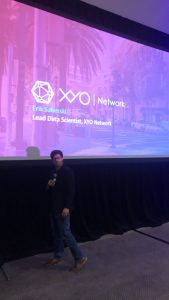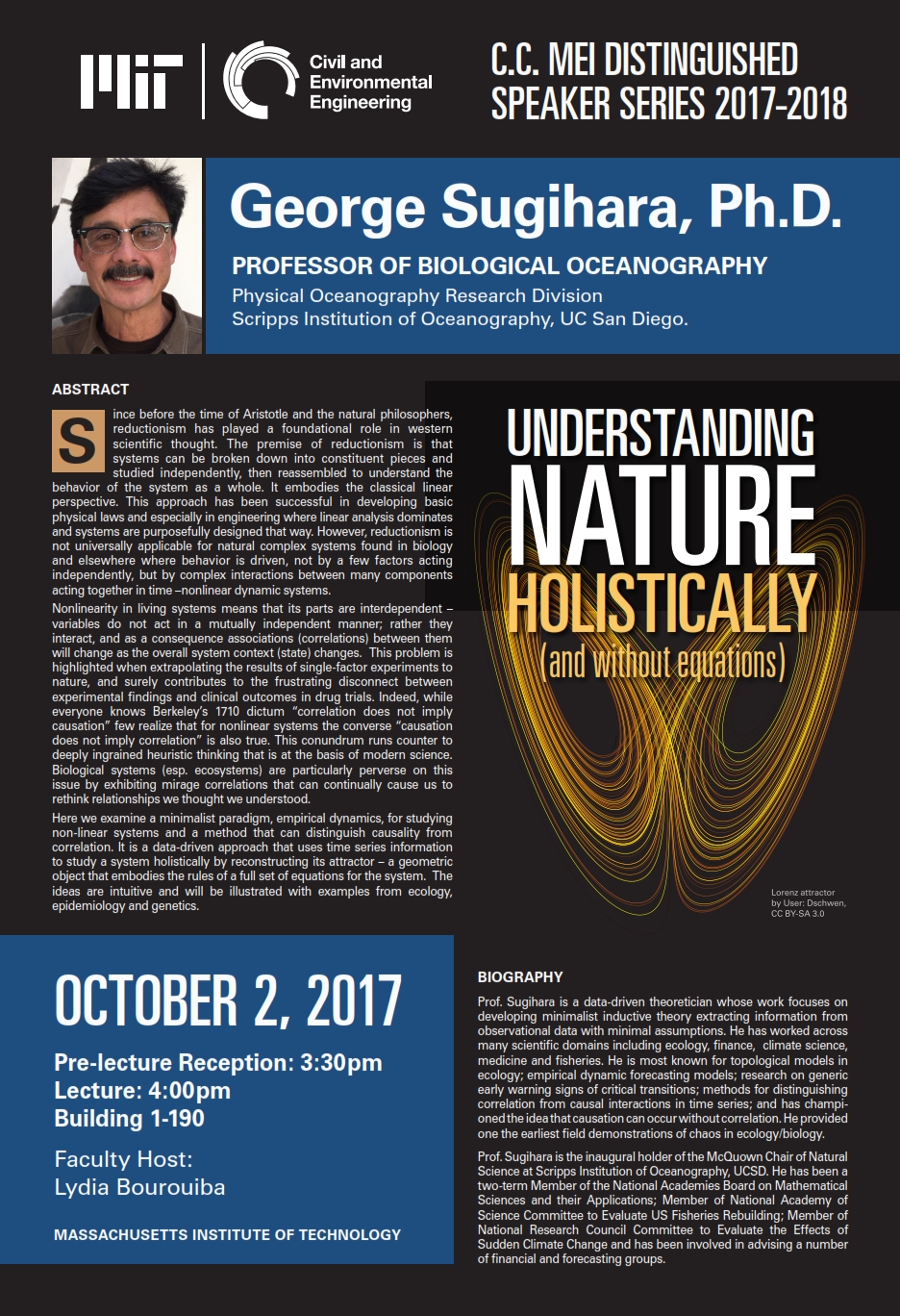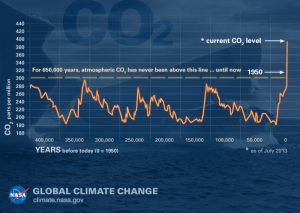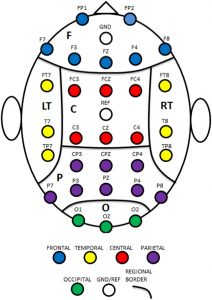September, 2024 – Gerald Pao’s recent work on Generative Manifold Networks, an EDM-based idea to simulate high dimensional brain activity using a network of low-dimensional attractors, is highlighted in the American Mathematical Society book “What’s Happening in the Mathematical Sciences.” Link to the book
September, 2024 – Erik’s thesis paper on scale and aggregation is accepted at Nature Communications… congrats!
March, 2024 – Professor Kazuyuki Aihara at The University of Tokyo Medical School, invited Sugihara to lecture on the lab’s recent EDM research.
February 26, 2024 – Sugihara attended the Okinawa Institute of Science and Technology (OIST) workshop on Low Dimensional Manifolds OIST Workshop “Manifolds in Nature and presented the opening keynote lecture “Causal Linkage in Dynamic Ecological Systems”.
January 25, 2024 – Erik Saberski defended his PhD thesis “Specific Solutions to General Problems in Data Science and Ecology”
December, 2023 – Sugihara Lab attended AGU23 in San Francisco. Click on the links to see abstracts. Erik Saberski, Delia Carpenter, Joseph Park, George Sugihara
June 6, 2023 – Professor Sugihara presented a keynote on “Invisible Causation” at the Halicioglu Data Science Institute’s 5th Anniversary Celebration.
February 13, 2023 – The Simons Foundation’s NonHuman Primate Neuroscience Consortium (NHPNC) invited Prof. S to speak on Inter-areal Communication and Causal Interactions in Brain Networks. The conference held in Manhattan highlighted work by Roozbeh Kiani and Luca Mazzucato showing how CCM successfully predicts experimental intervention effects ( https://journals.aps.org/prresearch/abstract/10.1103/PhysRevResearch.5.043211).
February, 2023 Professor Sugihara visited the Center for Infectious Disease Dynamics (CIDD) at Penn State University to meet with faculty and students and present “Taming Complexity in Data-Limed Nonlinear Nonequilibrium Settings”.
December, 2022 – Sugihara lectured on EDM at the Institute for Basic Science, Biomedical Math Group, in the Department of Mathematical Sciences, in Daejeon, Korea.
August, 2019 – Professor Sugihara travelled to Erice (Sicily) to attend an invited session on Planetary Emergencies. Organized by Ettorie Marjorana, the event’s intent was to be non-partisan. The event was created during the cold war with Vatican support to promote communication amongst scientists from both sides of the iron curtain to allow free exchange apart from politics. Professor Sugihara enjoyed a remarkable experience and met two very engaging climate change skeptics: Christopher Essex and Vaclav Klaus, the former president of Czechoslovakia.

August 1-3, 2019 – Prof. Sugihara will travel to Chapman University to give the Keynote at the International Society for Chaos Theory in Psychology and Life Sciences (SCTPLS) Conference.
June 3, 2019 – Prof. Sugihara will travel to the Harvard: Radcliff Insitiute for Advanced Study to give a seminar on causality and dynamics.
March 12, 2019 – Alfredo successfully defended his PhD thesis “Uncovering the complex dynamics of socio-environmental fisheries management” and is given the Walter Munk Award.
March 1, 2019 – Prof. Sugihara presented “Understanding Nature Holistically with Equation-free Mathematics at the UCSD Faculty Club university-wide lecture series.
November 27-29, 2018- Dr. Deyle traveled to Washington D.C. to represent the lab at the anual SERDP & ESTCP Symposium. He presented a poster in a session with the other grant participants to show our recent findings on using EDM to address non-analogue, non-stationary futures in ecological systems.

November 13-15, 2018- The Sugihara lab traveled to Santa Cruz for the Nonlinear Dynamics and Fisheries Workshop that Prof. Sugihara organized with Dr. Stephan Munch (NOAA SWFSC). Prof. Sugihara gave a lead-off presentation, “Empirical Dynamics: A Pragmatic, 21st Century, Data-Driven Outlook”. Alfredo Giron-Nava presented his ongoing work applying EDM to Pacific Sardine in the Gulf of California, and Dr. Deyle presented an overview of Multivariate EDM approaches and their potential applications to Ecosystem Management and Fishery Collapse. The workshop was a great opportunity to plan practical implementations of EDM in Fishery Management and also to catch up with many of our collaborators.
October-December, 2018- Assistant Professor Hiroaki Natsukawa (Koyamada Lab) returned for a 3-month visit to continue work on vizEDM. Stay posted for the products!
October 20, 2018- Erik Saberski spoke at the IDEAS SoCal Conference in LA. This is one of the largest annual conferences focused on AI and Data Science. Erik, who is also the Lead Data Scientist for a San Diego company, XYO Network, began his talk explaining how they are building novel technology that records interactions amongst people and objects, and stores this data on a decentralized blockchain. He then discussed how Empirical Dynamic Modeling techniques can then be used with this unique data set to get a deeper understanding of the hidden dynamics that govern our everyday lives.

August 2018 – Prof. Sugihara traveled to the PICES conference in Japan to present “A predictive modeling approach for single stocks, fish community and fisheries ecosystems” with Prof. Hui Liu.
March 2, 2018 – Prof. Sugihara spoke at the Halicioglu Data Science Institute, giving the opening remarks titled “Causation that is Invisible to Correlation”.
February 2018 – Lenfest news story about a Nature magazine report on an application of EDM with colleagues from Japan here.
February 15-19, 2018 – Prof. Sugihara travels to Austing for the AAAS conference where he presented on detecting causation in complex natural systems.
Identifying causal networks is important for policy and management recommendations on climate, epidemiology, financial regulation, and much else. We introduce a method, based on nonlinear state space reconstruction, that can distinguish causality from correlation. The approach is illustrated both by simple models and by application to real ecological systems, including the controversial sardine-anchovy-temperature problem.
January 2018 – MOU (memorandum of understanding) signing ceremony between Japan’s national lab on Artificial Intelligence Science and Technology (AIST) and UCSD to promote exchange and cooperation between AIST and UCSD (primarily SDSSC and HDSI, the new UCSD data science institute) . The MOU will make available the next generation supercomputer being brought on line this spring in Japan and provide resources to encourage the use of supercomputing and artificial intelligence in data science

October 2017 – Public lecture at MIT for the C.C. MEI Distinguished Speaker Series: “Understanding Nature Holistically (and without equations) “

June 2017 – Dhanurjay “DJ” Patil, the Nation’s first Whitehouse Chief Data Scientist (appointed by Obama for the United States Office of Science and Technology Policy), stops by the lab to visit his early mentor and catch up. DJ was on campus to accept a UCSD distinguished alumnus award. During DJ’s undergraduate career at UCSD, he worked in the Sugihara lab where he became interested in inductive data-driven approaches to complex systems. He applied EDM methods (residual delay maps and S-maps) to weather prediction and went on to do a PhD with Jim Yorke and Ed Ott at University of Maryland. DJ has been credited with coining the term “data-science.”
March 2017 -Salk Institute presentation on “An Equation-free Approach for Understanding Nature” .
October 2016 – Science feature: “‘Messy Math’ from Sardine Studies Could Help Fight Flu Outbreaks.”

A team of researchers led by Scripps researcher Ethan Deyle applied methods developed for understanding variability in sardine populations to flu. Looking at 18 years of data on worldwide influenza outbreaks, they found that humidity is the strongest factor in driving influenza, but that temperature also plays a role, combining in a complex way that past studies were unable to pick up on. They identify a specific temperature threshold (75F) below which moisture inhibits flu transmission and above which it promotes flu outbreaks Read more on Science.
August 2016 – Science Magazine report on “Information leverage in interconnected ecosystems: Overcoming the curse of dimensionality by Ye and Sugihara. This work presents a somewhat radical and entirely straightforward approach for dealing with complexity in dynamic interconnected systems. Contrary to current belief, the paper shows how complexity, in the form of multiple interacting components, can actually be an asset for studying natural systems from temporal data.The basic idea is that multidimensionality allows the system dynamics to be reconstructed from multiple viewpoints, and that these can be combined into a single model. Read more here.

March 2016 – Seminar at Duke Univeristy hosted by CEINT (Center for the Environmental Implications of NanoTechnology). Read the abstract and webstream on CEINT.
October 2015 – Article by Gabriel Popkin in Wired: “Is it Foolish to Model Nature’s Complexity with Equations?”
Trying to manage a major fishery with a primitive understanding of its biology seems like folly …. Their crucial insight? Throw out the equations. Read more on Wire.
August 2015 – Prof. Chih-hao Hsieh is awarded the Biwako Prize for Ecology.
April 2015 – Keynote Address at the International Symposium for Systems Biology “Correlation and Causation” video
Institute for Systems Biology Presents the 14th Annual International Symposium in Seattle April 6 & 7, 2015 This year’s topic “Tipping Points in Medicine & Ecology” was aligned with ISB’s focus on personalized medicine and environmental sustainability. The principles of critical phase transitions, early warning signs and, more generally, complex systems dynamics, offer a theoretical framework and analysis tools for understanding and predicting major state transitions in human health and in ecosystems. The Symposium facilitated the translation of these theoretical principles to medicine and ecology.
March 31, 2015 –PNAS Commentary: “Equation-free Modeling Unravels the Behavior of Complex Ecological Systems” Don L DeAngelis, Simeon Yurek.
With the term “equation-free” in the article title, Ye et al. (1) are suggesting broader implications of their approach, considering the centrality of equations in modern science. From the 1700s on, nature has been increasingly described by mathematical equations, with differential or difference equations forming the basic framework for describing dynamics. Read more on PNAS.
 March 30, 2015 – An international group of scientists use CCM to confirm that carbon dioxide is a causal driver of global temperatures and find evidence that supports a controversial link from global mean temperatures to greenhouse gases, Forbes.
March 30, 2015 – An international group of scientists use CCM to confirm that carbon dioxide is a causal driver of global temperatures and find evidence that supports a controversial link from global mean temperatures to greenhouse gases, Forbes.
To develop their conclusions, the team utilized a method to detect causality in complex systems developed in the Sugihara lab. These methods have been successfully used to determine issues of cause and effect in ecological systems where some variables may be dependent on one another, such as the relationship between sardine and anchovy populations with ocean temperatures in the Pacific Northwest. Read more on Forbes.
March 26, 2015 – The article “New fishery forecasting model ditches equations and assumptions, improves accuracy” from Fishsens Magazine mentions the higher accuracy obtained by EDM in predicting sockeye salmon returns. Read more on Fishsens.
March 9, 2015 – Accurate prediction of the Fraser River sockeye run mentioned in The Globe and Mail: “Scientists find way to better predict size of salmon runs in Fraser River”
Scientists at the Scripps Institution of Oceanography in California found their new method was more accurate than most preseason forecasts of Fraser River sockeye runs from the past 58 years. In 2014, they predicted the dominant sockeye salmon run would contain between 4.5 and 9.1 million fish, while the Fisheries and Oceans Canada forecast predicted a much broader range of 6.9 to 20 million. The actual run weighed in at about 8.8 million fish. Read more on the Globe and Mail.
January 2014 – “Tomorrow’s Catch – Chaos Theory’s Potential for Fisheries Management” in Science News
A management approach based on chaos theory could help prevent collapses of sardines and other valuable fishes. Read more on Science News.
February 2009 – “Using Chaos Theory to Revitalize Fisheries” in the Scientific American
There are fewer fish in the sea than ever. We argue that complexity theory provides a counterintuitive way to revitalize the world’s fisheries Read more on Scientific American.
Going beyond ecology
 December 2014 – National Center for Biotechnology Information: “Sugihara Causality Analysis of Scalp EEG for Detection of Early Alzheimer’s Disease.”
December 2014 – National Center for Biotechnology Information: “Sugihara Causality Analysis of Scalp EEG for Detection of Early Alzheimer’s Disease.”
This work exploits CCM causality analysis to develop novel EEG biomarkers for discriminating normal aging from mild cognitive impairment (MCI) and early Alzheimer’s disease (AD). Read more on NCBI.
October 2010 – Keynote speaker to the financial sector…8th annual Global ARC. “The Paradox of Diversification: Reducing Individual Risk through Portfolio Diversification Increases Systemic Risk” Read more about the 8th annual Global ARC.
Founded in 2002, Global ARC convenes a network of the world’s foremost pension funds, sovereign wealth funds, endowments, foundations and asset managers focused on the intersection of macro-economic developments, capital markets, and alternative investments. The relatively small but exclusive gathering represents on the order of several trillion US dollars in assets under management, and include luminaries such as Henry Kissinger, Paul Volker, Dick Cheney, Martin Feldstein and Peter Orszag among others.
May 2010 – Keynote speaker for the annual meeting of American Accounting Association CARE conference held in Miami. Managing Risk in a Dynamically Changing World. Video

